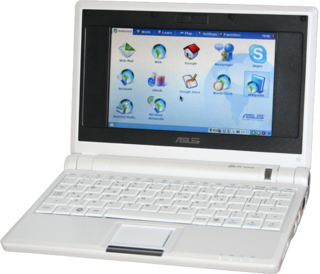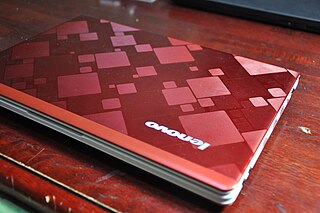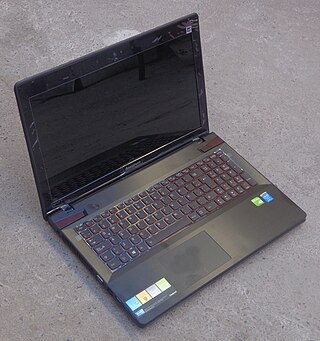Related Research Articles

ThinkPad is a line of business-oriented laptop computers and tablets designed, developed and marketed by Lenovo, and formerly by IBM until 2005, when IBM's PC business was acquired by Lenovo. ThinkPads have a distinct black, boxy design language, inspired by a Japanese bento lunchbox, which originated in 1990 and is still used in some models. Most models also feature a red-colored trackpoint on the keyboard, which has become an iconic and distinctive design characteristic associated with the ThinkPad line.
In computing, a hybrid drive is a logical or physical storage device that combines a faster storage medium such as solid-state drive (SSD) with a higher-capacity hard disk drive (HDD). The intent is adding some of the speed of SSDs to the cost-effective storage capacity of traditional HDDs. The purpose of the SSD in a hybrid drive is to act as a cache for the data stored on the HDD, improving the overall performance by keeping copies of the most frequently used data on the faster SSD drive.

Subnotebook, also called ultraportable, superportable, or mini notebook, was a marketing term for laptop computers that are smaller and lighter than a typical notebook-sized laptop.

A solid-state drive (SSD) is a solid-state storage device that uses integrated circuit assemblies to store data persistently, typically using flash memory, and functioning as secondary storage in the hierarchy of computer storage. It is also sometimes called a semiconductor storage device, a solid-state device or a solid-state disk, even though SSDs lack the physical spinning disks and movable read–write heads used in hard disk drives (HDDs) and floppy disks. SSD also has rich internal parallelism for data processing.

The ASUS Eee PC is a netbook computer line from Asus, and a part of the ASUS Eee product family. At the time of its introduction in late 2007, it was noted for its combination of a lightweight, Linux-based operating system, solid-state drive (SSD), and relatively low cost. Newer models added the options of Microsoft Windows operating system and rotating media hard disk drives (HDD), and initially retailed for up to 500 euros.

IdeaPad is a line of consumer-oriented laptop computers designed, developed and marketed by Lenovo. The IdeaPad mainly competes against computers such as Acer's Aspire, Dell's Inspiron and XPS, HP's Pavilion, Envy and Stream, Samsung's Sens and Toshiba's Satellite.

The ThinkPad X series is a line of laptop computers and convertible tablets produced by Lenovo with less power than its other counterparts. It was initially produced by IBM until 2005.

The IdeaPad S Series is a series of notebook computers launched by Lenovo in October 2008. The IdeaPad S10 was initially scheduled for launch in September, but its release was delayed in the United States until October.

The first laptop in the IdeaPad U series was the U110 launched in 2008 by Lenovo. Showcased at CES 2008, the laptop also launched the IdeaPad series itself, and received the Best of CES 2008 award. The IdeaPad U series was a line of Lenovo's consumer line of laptops, combining Lenovo's traditional engineering with design changes that were significantly different from ThinkPad products.

The IdeaPad Y series was a consumer range of laptops produced by Lenovo, first announced in 2008. They are marketed as premium high performance laptops for multimedia and gaming, as part of the IdeaPad line. The most significant differences from Lenovo's traditional ThinkPad business laptops were a more consumer-oriented appearance and performance-oriented components. IdeaPads feature a chiclet keyboard with rounded keys, similar to the latest ThinkPads. The first of the Y series were the IdeaPad Y710 and the IdeaPad Y510 notebooks, with screen sizes of 17 inches and 15 inches respectively. Not all features were entirely new, however. Notebook Review reported that the Y710 and Y510 notebooks had a keyboard that felt similar to the ThinkPad when used, despite the absence of the TrackPoint. The Y50 and Y40, released in 2014, featured a gaming-oriented design shift and slimming down. The latest release was the Y700 in late 2015.
The M-series of desktops are part of Lenovo's ThinkCentre product line. Formerly an IBM brand, Lenovo acquired the ThinkCentre desktop brand following its purchase of IBM's Personal Computing Division (PCD) in 2005. Following its acquisition of IBM's PCD, Lenovo has released M-series desktops in multiple form factors, ranging from traditional tower, to small form factor, and all-in-ones (AIOs).
The IdeaCentre K series desktops from Lenovo are described by the manufacturer as being gaming-oriented desktops. Typical features on the desktops include mid-range to high-end processors, discrete graphics cards, multiple hard disk drives, multiple RAM DIMMS, multiple USB ports, and multiple optical disk drives. The K Series desktops also come with a physical switch on the CPU that allows users to shift between different levels of processing power. For example, the K330 offered red for high performance, blue for moderate performance, and green for less processing- and resource-intensive tasks.
The Lenovo U300s is an Ultrabook-class notebook computer.
The Lenovo IdeaPad Yoga 13 is a convertible laptop created by Lenovo and first announced at the International CES 2012 in January. The Yoga 13 gets its name from its ability to take on various form factors due to its screen being mounted on a special two-way hinge.

Lenovo Yoga is a line of consumer-oriented laptop computers and tablets designed, developed and marketed by Lenovo, named for their ability to assume multiple form factors due to a hinged screen.

The ThinkPad X1 series is a line of high-end ThinkPad laptops and tablets produced by Lenovo.

The HP Envy is a line of consumer-oriented high-end laptops, desktop computers and printers manufactured and sold by HP Inc. They started as a high-end version of the HP Pavilion line.
The ThinkPad Twist is a 2-in-1 convertible tablet, that can function as a laptop and tablet released in 2012. The Twist is designed for business users and runs Microsoft's Windows 8 operating system.
The Lenovo IdeaPad Yoga 11 is a hybrid laptop/tablet Windows RT-based computer released in late 2012. The Yoga 11 gets its name from its ability to change form factors thanks to the two-way hinge used to mount its display. It was discontinued on July 17, 2013, due to the poor sales of Windows RT devices.
References
- ↑ AnandTech | Acer R7 Review: Something Different
- ↑ "Driver & Tools: ExpressCache". Archived from the original on 2015-12-08. Retrieved 2015-12-02.
- ↑ Samsung unveils Series 7 notebooks with ExpressCache - TechSpot
- ↑ Samsung Series 5 UltraTouch 13-inch Review | Windows 8 Laptop Reviews
- ↑ Sony VAIO T14 Ultrabook Review - Out With Express Cache In With DataPlex For SandForce Driven Speed | The SSD Review
- ↑ ExpressCache Driver(Condusiv) Update version 1.0.98.0 : Download : Sony Middle East & Africa
- ↑ Lenovo IdeaPad Y510p review | PC Pro
- ↑ ExpressCache software is not installed on ThinkPad and ThinkPad Edge systems with mSATA SSD device
- ↑ Hands On: Fujitsu Lifebook U772 | News & Opinion | PCMag.com
- 1 2 SanDisk SSD Technology Chosen for New Fujitsu Line of Ultrabook Computers | techPowerUp
- 1 2 Diskeeper ExpressCache halves Windows boot time | Crave - CNET
- ↑ SanDisk First To Tackle OEM SSD Caching Solution - Computex 2012 Update | The SSD Review
- ↑ SanDisk announces 32GB ReadyCache for Windows: $55 at Amazon, keep your existing HDD
- 1 2 HARDOCP - Specifications - SanDisk ReadyCache 32GB SSD Review
- 1 2 CDRLabs.com - SanDisk ReadyCache Solid State Drive | Reviews | All-Pages
- 1 2 Samsung 700Z Chronos review | PC Pro
- ↑ "Sandisk ReadyCache 32GB review". Expert Reviews. 2012-10-21. Retrieved 2014-05-13.
- ↑ "Test du SSD ReadyCache de SanDisk". PCWorld.fr. 2012-09-28. Archived from the original on 2014-05-06. Retrieved 2014-05-13.